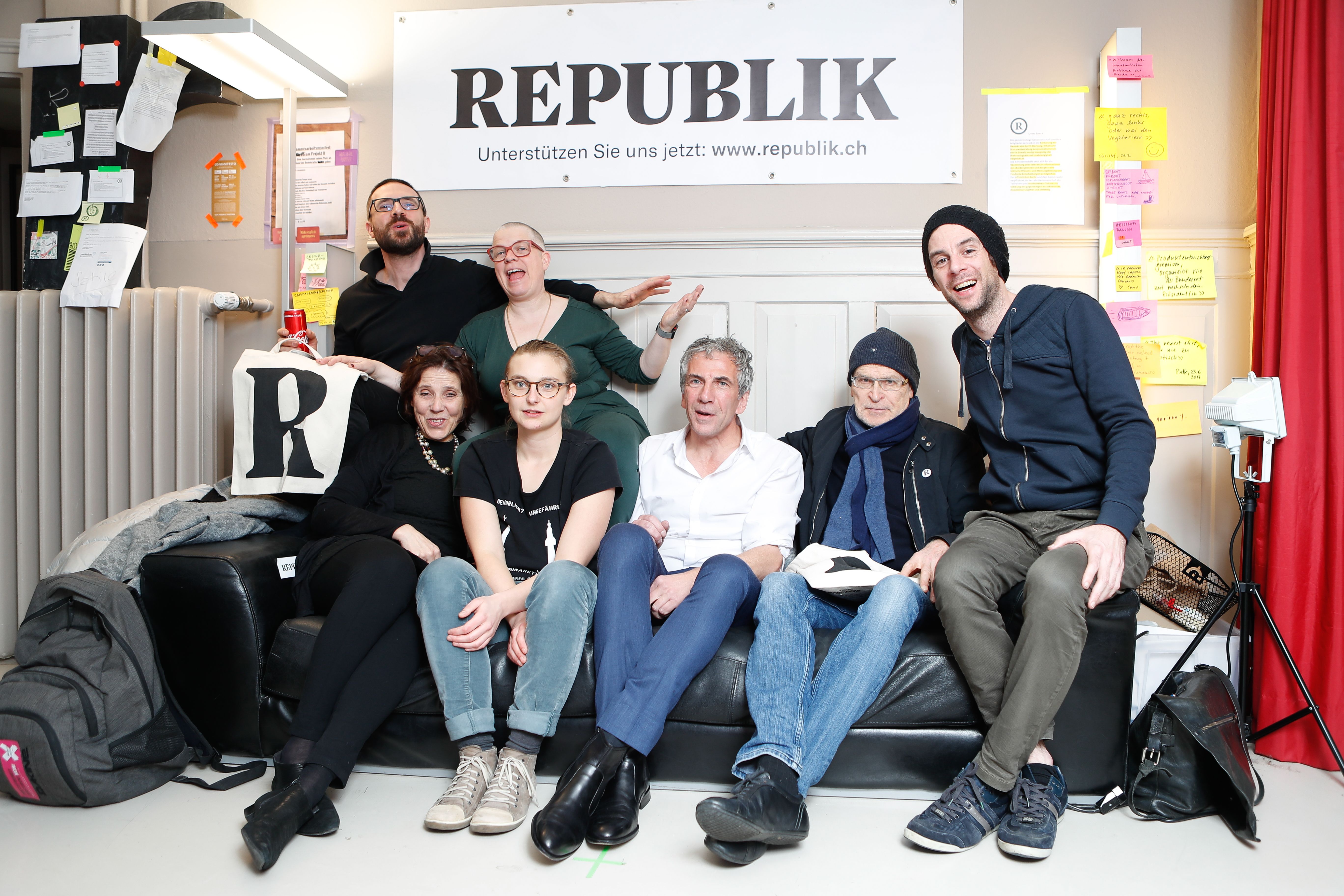
As legacy outlets continue to struggle with shrinking revenues, some journalists are venturing into media entrepreneurship
Graduation was approaching, and Northwestern University journalism student Stephanie Choporis faced a tough job market where her choices were few.
She could have sought out a spot at a major newspaper or broadcaster in Chicago or elsewhere, but those positions were few and competitive. She might have worked for a local newspaper or an equivalent online publication. But almost 2,000 local newspapers have closed since 2004, according to recent research. Many owners of the surviving publications have reduced their newsrooms as advertising and circulation revenues shrank. Editorial staffs shrunk by a quarter between 2008 and 2018, even as online news jobs increased, the Pew Research Center found. Choporis could have freelanced. That would probably be rewarding but certainly risky.
American and Canadian entrepreneurs launched on average two media startups a month from 2008-2017, according to research
As she weighed her options in the summer of 2015, Choporis and her fellow grad students had an opportunity to present their coursework to investor David Beazley, who was a Northwestern alum. The students had been tasked with creating a media company from scratch. Choporis and her team produced Happenstance, a mobile app that offered stories, backgrounders, and other info about Chicago’s neighborhoods via short audio pieces tied to specific locations in the city. Beazley thought Happenstance was a great idea and he offered to meet with Choporis periodically to provide guidance.
Beazley helped them draft a business plan, and staged mock interviews so they could practice for future sit-downs with investors. The training helped her see her potential as an entrepreneur rather than solely as a journalist. “If he didn’t come into the picture, I don’t think any of this would have been on any of our radar screens,” Choporis says. “He definitely gave us the learning blocks. I’ve learned a lot since then, but he laid the foundation for some things we needed to know early on. It’s good to have a mentor.”
Choporis finished school and worked in journalism. But within two years she realized she didn’t want to work for a small or big paper, or anyone at all. She also didn’t want to solely freelance. Instead, she refocused her energies on Happenstance and found entrepreneur Kathy Bartlett as a business partner.
Securing an office in Chicago’s 1871 tech hub, the two expected to launch the Happenstance app in 2019. They foresaw users uploading content and sponsors— like museums, local restaurants, or organizations—underwriting audio stories. They paid freelancers to produce stories about the streets of the Windy City, focusing on the hipper neighborhoods. Millennials were most likely to become Happenstance’s audience in the future, they forecasted.
Choporis was following a well-worn path. American and Canadian entrepreneurs launched on average two media startups a month from 2008 through 2017, according to researcher Michele McLellan, who tracks independent online local news outlets with support from the Reynolds Journalism Institute. The trend was arguably an answer to a crisis rooted in the failure of journalism’s old and new business models.
After years of print newspapers foundering in the Internet era, hedge fund and private equity firms entered the sector, gobbling up cheap local news outlets that still make money from ads while cutting staff to boost returns. Upon announcing plans to acquire the Gannett newspaper empire in August, for example, GateHouse executives promised to cut $300 million in costs from the merged company. The market hasn’t been kind to online publications that once offered hope of a resurgent journalism, either. BuzzFeed’s viral content and native advertising have yet to consistently turn a profit. Vice has endured numerous staff cuts and restructurings. Mic once promised to appeal to millennial audiences, raising about $60 million in venture funding. It turned out to be a bad bet, at least from the investors’ perspective. Last year it was sold for $5 million. Additionally, greater challenges lie beyond finance. Tech titans like Apple, Google, and Facebook are expanding their control over the news. Even institutions like The New York Times and The Washington Post must reckon with their influence.

Journalist Stephanie Choporis, pictured, teamed up with entrepreneur Kathy Bartlett to try to make her mobile news app Happenstance a reality
Entrepreneurs find opportunity in adversity, however. The technical barriers to launching a new digital media venture—a website, podcast, or newsletter, for example—are as low as ever. Startups have multiple options for financing, including subscriptions, online ads and sales, crowdfunding, grants, and venture capital.
Media entrepreneurs today have also learned lessons from the countless ventures that have succeeded and failed since the advent of the Internet in the 1990s. Those experiences have led to a proliferation of incubators, innovation labs, fellowships, and other programming for would-be job creators. They in turn have taken aim at social barriers to entrepreneurship, like sexism and racism.
Some new businesses have flourished in that climate. The Information, which covers the tech industry; The Canary, a left-wing British political news website; and The Daily Skimm, a daily news digest for young urban women, have demonstrated how niche publications can leverage the power of high-caliber journalism, loyal readers, and tech innovations. Founded by former NBC producers Danielle Weisberg and Carly Zakin, the Skimm’s newsletter now has more than 7 million subscribers. Some journos have also graduated to blockbuster media maven status. In early 2019, “Planet Money” podcast co-founder Alex Blumberg sold his media company, Gimlet, to streaming platform Spotify for $230 million, arguably making him one of the most successful journalist-entrepreneurs ever. One-time reporter Hamish McKenzie cofounded SubStack, a newsletter platform that has been wildly successful. Relative newcomers to news have joined the ranks of the mainstream media, too, as the successes of Politico and Vox attest. Founded in 2007 and 2014 respectively, they have proven their mettle in the hyper-competive but news-rich Washington, D.C. market. Their founders left The Washington Post and Slate to pursue their brand of journalism online.
That’s not to say entrepreneurship is easy.
In the summer of 2019, Choporis and Bartlett hit snags. Bugs in their app were taking longer to fix than they expected. The pair were funding Happenstance themselves. With limited resources, the technical side of the business was eating into their budget for freelancers and content.
“It felt like 70 percent of what we did was talking or vetting people who could possibly do a certain job,” says Choporis. “It became tiring. My heart was just not
in it as much anymore.”
They decided to shut down the company by the end of the year. Instead of an app, they would put their audio stories up on their website, if only to show the fruits of their efforts. People could visit and hear their work indefinitely. But the founders would move on. They had envisioned an app that married geolocation technology with storytelling. The decision was hard and saddening, but Choporis also felt relieved and thankful for having the opportunity to work on her own business.
“I often like to turn every stone before I decide, ‘Ok, there’s nothing more that can be done here,’” says Choporis. “It just didn’t feel to me that it could have gotten too much farther than we already are.”
Happenstance was hardly alone. Approximately 20 percent of the 329 for-profit online local news startups that McLellan has studied did not survive for five years or more. According to her 2019 survey of 92 online local news publishers, around 40 percent generate revenues of $50,000 or less, hardly a sustainable figure. Two-thirds said their primary source of revenue is locally sold advertising.
The technical barriers to launching a new digital media venture are as low as ever
Those odds led mentors to implore journalist-entrepreneurs to be realistic, keep overhead low, and stay open-minded to making changes in their business models.
“The misconception [among some business creators] is that they need to start really big and aim for some giant community or audience or big group,” says Jeremy Caplan, who worked with startup founders for years at the Tow-Knight Center for Entrepreneurial Journalism at the City University of New York. “What we really need to do is be much more lean-startup oriented, much more nimble and small, and run little experiments.”
With that advice in mind, here’s a look at some of the challenges and opportunities for prospective media entrepreneurs:
Find Your Community
Entrepreneurship can be a lonely business, especially in the beginning. Some successful journalist-entrepreneurs, however, have created communities that stave off the sense of isolation that might otherwise drive off budding founders and creators.
Journalist Sherrell Dorsey has worked as a writer, techie, and marketer in the fashion and tech industries. In 2016, after freelancing for magazines like Black Enterprise and Fast Company and using her data journalism skills at Uber and Google Fiber in Charlotte, North Carolina, she founded ThePLUG, a newsletter covering the black innovation economy. “ThePLUG contextualizes work done by black people, calling out a larger narrative on how innovation is moving forward,” says Dorsey. “These folks are unsung.” With partnerships with Vice’s tech vertical Motherboard under its belt and a grant, ThePLUG now has “several thousand” subscribers, Dorsey says, and raises sufficient revenues for her to hire a managing editor and pay freelancers in the United Kingdom, New York, San Francisco, and South Carolina.
The newsletter wasn’t enough for Dorsey, though. She was writing about innovation but doing little to foster it in her backyard, even though Charlotte has become a tech hub where black entrepreneurship is high relative to the rest of the U.S. African Americans comprise 13 percent of the nation’s population but only 0.5 percent of American-born innovators, according to data cited in a PLUG story produced with Vice about black-owned co-working spaces.
Dorsey wanted to build on the success of ThePLUG and create a supportive environment where her community might grow stronger. She launched BLKTECHCLT, an organization dedicated to fostering entrepreneurship in Charlotte’s African American community.
Since its founding in 2016, around 2,000 people have attended networking events, signed up for seminars with successful business owners, coding workshops, or become members for $150 a year, says Dorsey. She and her colleagues partnered with the nonprofit Carolina Small Business Development Fund to raise $100,000 for microloans to local startups. BLKTECHCLT, in other words, has become a mini financier supporting new businesses in Charlotte.
Find Your Audience
If you are a news startup, you better identify your audience well before you go live. In the age of the internet, audiences are like gold veins. If you find a good one where no one else has a claim, don’t stop digging. David Skok thought Canada might have some gold veins.
Skok climbed the ladder at Canadian-based Global News, was managing editor and vice president of digital for The Boston Globe, and, finally, head of editorial strategy at the Toronto Star. But, after three months of working at the Star, he left in January 2017 feeling disappointed. He couldn’t serve the role as innovator when his superiors cared only for cutting costs. “When I left the Star, I was tired,” he says. “I was tired of going through staffing rosters and thinking about a layoff, a buyout, or a hiring freeze. Like any editor will tell you in any newsroom, it starts to eat at your soul.”

The Logic team at Toronto’s Collision Tech Conference in May 2019. From left: Murad Hemmadi, Jessica Galang, Catherine McIntyre, David Skok, Hanna Lee, Amanda Roth, and Zane Schwartz
He had no interest in working for another big company. He realized that he would need to do something himself if he wanted to stay in journalism.
Skok had long followed tech developments throughout North America. He knew Jessica Lessin’s The Information was wildly successful. As a Canadian, however, he also knew that nobody delivered tech news like Lessin but focused on companies in Canada. That led to the idea that inspired him out of his funk: The Logic, founded last year. “I was reminded that I was a creative person,” he says. “It never felt like work.”
Skok wouldn’t disclose the number of his subscribers. But his $300 annual fee supplies enough revenue to hire around seven people, including editors and reporters, he says. The paywall and subscriptions are essential parts of his business plan. They provide the consistent revenue that a newsroom needs to focus on reporting of significance. A subscription service, increasingly popular among media startups, was an easy fit with his tech-friendly target audience, who value information about their industry.
Those readers also appreciated The Logic’s scoops, interviews, and insights. Last year, The Logic broke news that the Canadian government has studied the idea of selling off highways, airports, and publicly owned companies, including the post office, to raise $200 billion.
Canada’s mainstream outlets have been watching. In May, Skok signed a reprinting deal with Postmedia, a nationwide Canadian media company that became The Logic’s minority partner, publishing the website’s content in as many as 140 newspapers throughout Canada. More recently, in November, The Logic announced it had raised $1.8 million from Postmedia, Relay Ventures, and angel investors. The Logic was attractive to investors precisely because it had demonstrated there was an audience for news about Canadian tech.
Stick to Your Beat
Natalia Antelava and Ilan Greenberg have been around. The former roamed the Middle East, Central Asia, and India for the BBC. The latter wrote for National Geographic, The New York Times, Slate, and The Wall Street Journal in Hong Kong, Russia, and the former Soviet Union. Flatmates in Kazakhstan, the pair kept in contact as they settled down in their respective countries. Antelava went home to Tbilisi, Georgia while Greenberg headed for New York City.
As they discussed their futures, news startups like Chalkbeat, which is devoted to education, and The Marshall Project, which covers criminal justice, were beginning to win accolades. Antelava and Greenberg wondered if they might build on their skills as foreign correspondents and leverage their contacts abroad to create a news website focused on global affairs. In 2016, not expecting to find investors anyway, they created a U.S.-based nonprofit called Coda Story, with most of their editorial staff based in inexpensive Tbilisi with Antelava.
From a fundraising perspective, they picked a good first beat: Russia and former Soviet republics. They reported on topics that international organizations and pro-democracy groups want to impact but daily news organizations rarely cover deeply, like disinformation, migration, and LGBTQ discrimination.
They started with $50,000 from crowdfunding platform Indiegogo and a small grant. In the next year, they received almost $200,000 in grants. Once they proved they could produce good work with that funding, they could make a case to grantors for more. To date, they estimate that they’ve raised as much as $1.6 million in crowdfunding and grants.
Mentors implore journalist-entrepreneurs to be realistic, keep overhead low, and stay open-minded to making changes in their business models
They owe their success to following what they viewed as best practices. For crowdfunding, they produced promotional video testimonials explaining their idea and appealed to their friends, family, and ample contact lists, a process that almost became a full-time job and sometimes made them feel like pushy salespeople. “It was painful,” says Greenberg. “It was assuring people that we would either never or rarely go back to them,” he says. “To do crowdfunding, it’s going to be an uncomfortable experience if you are going to be successful.”
Today, as Wired magazine and foreign newspapers often reprint their work, Coda’s co-founders are trying to figure out how to wean themselves off grants, which can only grow an organization so large before “development”—an institutional term for “finding money”—takes over the business.
They held a storytelling conference in Tbilisi, launched Coda newsletters devoted to their projects, and run an animation and video production studio that has already produced content for the BBC and ProPublica.
Greenberg and Antelava are hiring staff in New York to expand their talent pool, including specialists who could boost audience engagement and raise money from investors or collaborators. Greenberg hopes they can land a deal with Netflix, Hulu, or a similar streaming platform that would run longer, thought-provoking foreign news videos that Coda might produce. Someone, he believes, is prepared to underwrite quality foreign news on their private network.
Learn from Your Failures
Entrepreneurs who fail at least have an opportunity to not repeat their mistakes.
The Worcester Sun accumulated around 5,000 paying subscribers and around 30,000 addresses on its email list before it ran out of money in 2018. The $2-per-week online publication and weekly print edition that covered the former mill city in Central Massachusetts was an attempt to fill what many perceived as the vacuum left behind by the diminished Telegram & Gazette, a 153-year-old local institution that has suffered deep cuts since corporate owners took control in 2015.
Founder Mark Henderson, a former sports reporter who rose to run the Telegram’s digital operations, didn’t give up after the Sun went dark, however. A 15-year veteran of the T&G who was ousted as the new owners took control—“I’m not a go along, get along guy,” he says—Henderson pivoted and used his enormous database of readers to launch The016.com, a social network for Worcester that offers personalized feeds of local news, sports, police log, obituaries, and deals from local businesses.
The016.com mostly offers curated info, like links to the latest news stories about the region. But sometimes Henderson breaks news. Citing public records, the 016 was the first to report on the recent sale of a blighted but beloved collection of shops as part of a major downtown reconstruction project, for example.
Entrepreneurs who fail at least have an opportunity to not repeat their mistakes
Henderson and his business partner Kevin Meagher have secured a handful of advertisers who have kept the free site afloat. The 016 now has 4,600 subscribers and garners more than 300,000 pageviews per month. In Worcester, that’s arguably a success. But it takes a lot of work. “Barrier to entry being low doesn’t mean there is a corollary to success,” he says. “Starting something new is hand-to-hand combat.”
Henderson has learned not to overextend. The Sun sank after he launched the print version, which proved too costly. Today, Henderson is focusing on leveraging his greatest asset: his data. He’s seeking funding for a suite of applications to help him analyze how 016 users behave. Those analyses might yield insights for tailoring content, garnering info for advertisers and monetizing traffic in other ways. In the long-term, he wants to post a profit and seek investors who might replicate his hyperlocal virtual social network across the country.
Find Your Business Partner
Journalists tend to have little experience on the publishing side of the business: monthly sales, information technology, human resources, annual budgeting, vendor contracts, and the like. Overseeing those duties while also writing, reporting, and editing can be a tough balancing act that illustrates why successful journalist-entrepreneurs often seek out business-minded collaborators.
Mónica Guzmán started working at the Seattle Post-Intelligencer in 2007 as the paper’s first online-only journalist. She left the newspaper in 2010 after Hearst gutted the staff and ended the paper’s print publication. She continued as a freelancer but by 2016 she and her friend, then-Seattle Times engagement editor Anika Anand, felt as if they wanted more out of life personally and professionally.
Maybe they could start their own business. “If I don’t do it now, if I don’t take a plunge and take a risk, what am I doing?” Guzmán recalls asking herself at the time. They thought there was a market for stories about the interactions between so-called Seattle lifers, or natives, and the newcomers working at the city’s multinational giants and the spinoffs. Both groups also wanted news and info that affected their day-to-day lives.
Readers prefer newsletters, Guzmán and others like CUNY’s Caplan say, because they give them control. Bombarded constantly with ads and paywalls and passwords, newsletter readers don’t need to log in. They read on their own timetable and become loyal quickly. “Signing up is simple,” says Caplan. “People don’t unsubscribe as readily as you’d expect.”
Guzmán and Anand knew they needed advice and help to launch a startup. They had friends at a digital publisher in Florida, WhereBy.Us, whose newsletter, The New Tropic, was growing and turning a profit. Guzmán and Anand approached WhereBy.Us, figuring they could use the same business model and tech to duplicate that success.
Guzmán and Anand liked the New Tropic’s conversational style. They gelled with the WhereBy.Us team. The company also brought expertise in website and newsletter design, a business model in generating subscriptions and ads, and other services they would otherwise have had to learn from scratch. The two sides agreed that the company would launch the website, with Anand and Guzmán running it editorially. Over the course of a three-day meeting, Guzmán, Anand, and WhereBy.Us staffers came up with the name The Evergrey, a reference to Seattle’s rainy weather.
“We convinced them to expand to Seattle and make this thing possible,” she says. “I know of cases where that has gone horribly wrong. But here we are three years in and it’s been great.”
Today, The Evergrey has around 12,400 subscribers, says Guzmán. It’s free, but some readers pay to support the effort. The Evergrey also helps produce ads for its newsletter and seeks out sponsorships for themed special issues.
Guzmán and Anand’s work at The Evergrey landed them leadership roles at WhereBy.Us. Guzmán recently handed the reins of The Evergrey over to a new editor and took a position overseeing the company’s newsletters in several cities. Anand worked as director of storytelling at WhereBy.Us before moving to Local Independent Online News Publishers (LION), an association for local independent online news publishers.
In her new job, Guzman didn’t feel as if she let go of her baby. She and Anand set out wanting to strengthen local journalism and offer Seattleites a good read. They succeeded. “My baby didn’t exist before WhereBy.Us,” says Guzmán.

The six founding members of Republik, pictured in January 2018 on the German-language publication’s launch day. The team—from left, Laurent Brust, Susanne Sugimoto, Nadja Schnetzler, Clara Vuillemin, Constantin Seibt, and Christof Moser—is joined by German investigative journalist Günter Wallraff, second from right
Find Your Investors
Switzerland-based, German-language online newspaper Republik, which launched in January 2018, has raised almost $6 million from crowdfunding and investors. The site’s success and the support of readers and investors, the founders say, reflect the public’s frustration over the mainstream Swiss media. They and others have complained of a few large media corporations buying and merging several independent Swiss newspapers and television and radio stations in recent years, concentrating a formerly diverse media market and driving down quality. Staff at mainstream dailies owned by Tamedia, for example, have complained about deceptive advertorials. At the same time, big new waves of investments are coming from the likes of far-right, Euroskeptic, anti-immigration politician Christoph Blocher whom Swiss media watchdogs have accused of promoting right-wing perspectives in the formerly politically neutral newspapers that he’s purchased in recent years, including disproportionate, positive coverage of Blocher’s Swiss People Party.
Running a website, newsletter, and app, Republik recently published an investigation into Zurich prosecutors hiring thuggish private security guards to apprehend and question suspects.
Housed in the Hotel Rothaus in Zurich, Republik is a for-profit business with 50 full-time and part-time employees, plus freelancers. The founders created a cooperative, Project R, that controls 49 percent of the shares in the business. Subscribers and other donors are automatically shareholders in Project R. Six co-founders own around 35 percent. Investors, who contributed mostly to support the Swiss press rather than receive a big return, own another 15 percent. The model gives the publication a legal way to raise money publicly, but ensures that someone other than the founders and original investors retain control of the company.
Successful journalist-entrepreneurs often seek out business-minded collaborators
Co-founder Clara Vuillemin was the in-house tech expert when Republik launched. Creating an ownership mindset was a challenge. She often found herself needing to corral the journalists to manage the business rather than analyze it, for instance.
Lately, Vuillemin has been making decisions that no journalist wants to make. She’s been cutting newsroom spending. Costs are outpacing revenues. Those numbers need to reverse if they are going to find any new investors. The publication has 18,000 subscribers but needs at least 25,000 to be sustainable, she says. They are looking for a further $1 million in funding that might help keep them afloat as they build up their base of paying readers.
Vuillemin is optimistic, though she knows she and her partners still have plenty to learn.
Today, Choporis describes herself as a “recovering entrepreneur” as she applies for full-time jobs and serves as an officer of the Chicago Journalists Association. She has few regrets. In hindsight, she and Bartlett should have found a tech developer who had committed to be a third partner. But her personal growth and the experience in the media and business she acquired over the past few years were life-changing. That said, she doesn’t foresee launching another business anytime soon, precisely because she knows the dedication it would entail.
“I would caution people to take that leap,” she says. “It’s great if they have a passion for it. But if they think it will happen quickly and easily, it doesn’t. Do it if you are certain this is what you want to do and if you have the means to do it.”
An earlier version of this story failed to accurately describe Anika Anand’s position at The Seattle Times and her editorial role at The Evergrey. It also misidentified LION.


